|
||||||||||
|
|
||||||||||
|
||||||||||
|
|
||||||||||
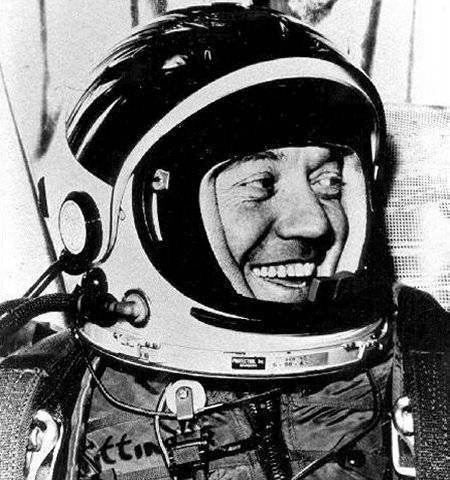
Joe Kittinger was born in 1928 and became interested in aeronautics at a young age. He had made his first solo fight by the age of 17 and joined the Air Force by 21. Kittinger received his wings in 1950 and served as a pilot in the 86th Fighter-Bomber Wing at Ramstein Air Force Base in Germany until 1953. In 1954, he became a test pilot for the Air Force Missile Development Center at Holloman AFB in New Mexico where Kittinger flew experimental fighters and became involved in aerospace medical research. One project he participated in was a rocket sled experiment that accelerated Colonel John Paul Stapp to high speeds in order to determine how gravitational stress affects the human body.
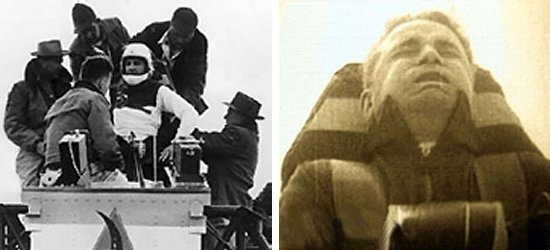
Stapp later became a leader of the Air Force's high-altitude research program and recommended Kittinger as a test pilot. This research effort explored the ability of humans to survive and function at high altitudes and helped support the early space program. Kittinger first joined a program called Project Man High in 1956. This program experimented with using a balloon to carry a man to high altitude in order to study the effects of cosmic rays on human physiology and psychology. The balloon reached such high altitudes that the pilot flew above 99% of the Earth's atmosphere in a space-like environment for extended periods of time. Due to the low density at such extreme heights, the balloons used were massive with a diameter over 172 ft (53 m) and a volume of 2 million ft³ (56,600 m³). Suspended beneath was a gondola containing a cramped capsule for the lone pilot. Kittinger completed the first Man High ascent on 2 June 1957 and remained aloft for almost seven hours. He reached a peak height of 96,760 ft (29,500 meters) and set a balloon altitude record. Kittinger was awarded the Distinguished Flying Cross for his efforts.
Kittinger next joined the Escape Section of the Aerospace Medical Research Laboratory located at Wright-Patterson AFB in Ohio in 1958. He became a test pilot in Project Excelsior that explored the ability of a human to survive escaping from a high altitude capsule by parachute. Kittinger made a series of three jumps from the open gondola of a balloon while wearing a pressurized suit to survive in the cold sub-zero temperatures and low pressures high above the Earth's surface.
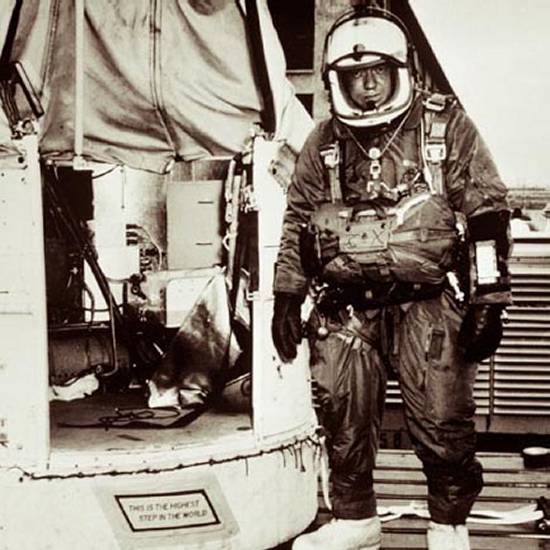
Kittinger's first high-altitude jump came on 16 November 1959 when he bailed out of the Excelsior I balloon at a height of 76,000 ft (23,165 m) over the New Mexico desert. He carried a small parachute intended to open after Kittinger had fallen for 16 seconds. This small chute would stabilize his decent and prevent Kittinger from going into a flat spin. However, a malfunction in the parachute caused it to open after just two seconds into his fall and wrap around Kittinger's neck. As he began to spiral uncontrollably, Kittinger quickly became unconscious and hurtled toward the Earth while tumbling at a rate of 120 revolutions per minute. Thankfully, his emergency parachute worked as designed and opened automatically once Kittinger had fallen to 10,000 ft (3,050 m). The parachute slowed Kittinger's rate of descent and saved his life.
Just three weeks after his nearly fatal close call, Kittinger made his next jump from the Excelsior II on 11 December 1959. Kittinger piloted the balloon to 74,700 ft (22,770 m) before he stepped out of the gondola on his trip back to Earth. His record free-fall lasted 55,000 ft (16,765 m) before Kittinger pulled his ripcord and his parachute deployed for a safe landing. The successful jump earned Joseph Kittinger the Leo Stevens parachute medal.

Captain Kittinger's third and final attempt came on 16 August 1960. He was lifted high into the stratosphere while riding in the gondola of the Excelsior III helium-filled balloon and reached a new record altitude of 102,800 ft (31,330 m). Kittinger's mark broke the previous record held by Major David Simons who had climbed to 101,516 ft (30,942 m) aboard the Man High II balloon in 1957. It took Kittinger an hour and a half to float up to his peak altitude, although a problem arose at 43,000 ft (13,105 m) when he felt a sharp pain in his right hand due to a failure in the glove of his pressure suit. Although the problem could have aborted the mission, Kittinger chose to continue.
Kittinger remained at his peak altitude, over three times higher than a commercial airliner typically flies, for about 12 minutes before he stepped off the "Highest Step in the World" to begin his fall to the Earth's surface. In addition to his pressure suit, Kittinger carried instruments and safety gear that weighed as much as he did. He also wore several layers of clothing to help protect him against the extremes of his high-altitude environment. During his fall, Kittinger experienced air temperatures as low as -94°F (-70°C)!
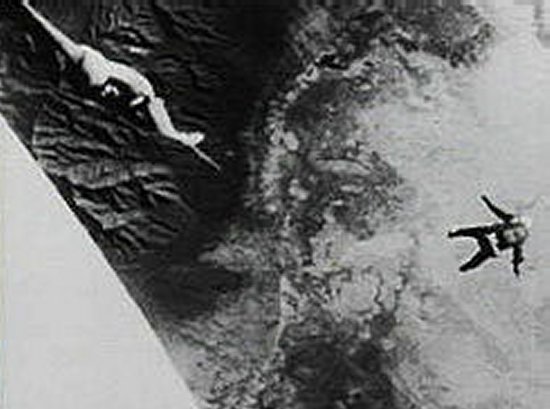
He had fallen for 13 seconds when he opened a small 6 ft (1.8 m) stabilization parachute to prevent spinning, but his free-fall continued for a total of 4 minutes 36 seconds until Kittinger's main 28 ft (8.5 m) parachute deployed at an altitude of 18,000 ft (5,500 m). This chute allowed the pilot to slow his decent and make a gentle, safe landing in the New Mexico desert about eight minutes later. In addition to the extreme pain in his right hand, Kittinger also suffered breathing difficulties between 90,000 and 70,000 ft (27,430 to 21,225 m), but these problems did not prevent his successful jump.
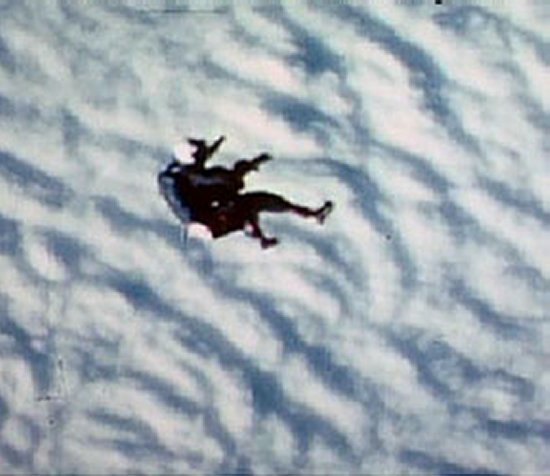
His amazing jump set several records that still stand today. Kittinger's records include the highest balloon ascent to 102,800 ft, highest parachute jump from 102,800 ft, and longest free-fall of 4 minutes 36 seconds. Kittinger also set a record for the fastest speed by a man through the atmosphere of 614 mph, although he later said he "had absolutely no sense of the speed." The Air Force honored his achievements during these three jumps by decorating him with the oak leaf cluster for his Distinguished Flying Cross, and Kittinger was also awarded the C.B. Harmon International Trophy by President Dwight Eisenhower in 1960.
The greatest accomplishments of Projects Man High and Excelsior had been to prove that, given the proper protection, a person could indeed survive in the near-space environment of extremely high altitudes. Kittinger's jumps also demonstrated that a pilot could bail-out from an aircraft at high altitude and free-fall through the Earth's atmosphere to make a safe parachute landing.
Although his record-setting jump was probably the highlight of this research, it was not the end of Kittinger's involvement in high-altitude ballooning. He next joined Project Stargazer that had begun at Holloman AFB in 1959. The purpose of Stargazer was to take a balloon to high altitude and conduct astronomy experiments while above 95% of the Earth's atmosphere. This vantage point gave observers a view of the stars free from the visual distortion that the atmosphere induces.

On 13-14 December 1962, Kittinger and astronomer William White rode in the two-person Stargazer balloon to an altitude of 82,200 ft (25,055 m) and hovered in place aboard the gondola. The pair remained aloft for 18 hours while making telescope observations and comparing the brightness of star images to those measured lower in the atmosphere. The long-duration flight also provided an opportunity to gather data on improving life support systems needed to survive at the edge of space for long periods. The ascent was the final high-altitude balloon experiment that Joseph Kittinger participated in.

Kittinger later volunteered for service in the Vietnam War where he served three combat tours. Kittinger flew 483 missions and became commander of the 555th Tactical Fighter Squadron. Unfortunately, Kittinger was shot down on 11 May 1972 and spent nearly a year as a prisoner of war in North Vietnam. Following his release, Kittinger remained in the Air Force until he retired in 1978 with the rank of colonel. He then went to work for the aerospace company Martin Marietta. Among the many decorations Colonel Kittinger earned during his military career are the Silver Star with Oak Leaf Cluster, Legion of Merit with Oak Leaf Cluster, Distinguished Flying Cross with four Oak Leaf Clusters, Bronze Star Medal with "V" device and two Oak Leaf Clusters, Meritorious Service Medal, Air Medal with 23 Oak Leaf Clusters, Purple Heart with one Oak Leaf Cluster, and a Presidential Unit Citation.
Even in retirement, however, the lure of ballooning was too strong for Joseph Kittinger to resist. He began flying balloons around the country and entered several balloon competitions. Kittinger won the Gordon Bennett Gas Balloon Race four times during the 1980s, and his third win allowed Kittinger to retire the prestigious Gordon Bennett Cup. He also set a world record in November 1983 by flying a helium balloon over 2,000 miles (3,220 km) from Las Vegas to New York in just 72 hours.
Kittinger later became the first person to complete a solo balloon flight across the Atlantic Ocean from 14-18 September 1984. Starting in Caribou, Maine, Kittinger landed in Cairo Montenotte, Italy, after a flight time of 83 hours and 40 minutes aboard his balloon the Rosie O'Grady. The flight covered a distance of 3,543 miles (5,702 km) and set records for the longest solo balloon flight to that time and the greatest distance flown by a 3,000 cubic meter helium balloon.
Joseph Kittinger no longer pursues aviation records, but he has continued to fly all his life. Over the course of his life, Kittinger has flown 78 different types of aircraft and tours the country with his open-cockpit biplane offering to take children on their first flights. Kittinger also set a speed record from Philadelphia to Orlando while flying a Piper Cheyenne 400 on 9 February 1986.
In recent years, at least three skydivers have proposed attempts to break Kittinger's record and jump from even higher altitudes. Cheryl Stearns is a member of the US Army Reserve who had originally planned to jump from 130,000 ft (40,000 m) and hoped to reach a peak speed of about 885 mph (1,425 km/h), or Mach 1.3. The attempt had been planned for 2001 and was most recently scheduled for October 2006. However, Stearns' website indicates that she no longer intends to make the jump from such a high altitude due to the risk involved.
"I had set my sights on a high altitude free-fall record near the top of the stratosphere: 130,000 feet. For me, it was the ultimate goal. But after working on this project for the past few years and carefully researching the required technology, I have determined that it is not feasible for me to safely jump from that high an altitude at this time."Stearns instead plans to jump from an altitude closer to 100,000 ft (30,500 m) in order to collect information to improve the state of current technology. She also hopes to break the record for longest free-fall of 80,384 ft (24,501 m) set by Russian Eugene Anreyev in 1962.
Another contender hoping to break Kittinger's record is Rodd Millner of Australia. Millner is a "former army reservist and night club bouncer" who had planned to jump from 130,000 ft (40,000 m) in March of 2002. Millner had indicated he planned to reach a top speed anywhere from 700 to 1,100 mph (1,125 to 1,770 km/h). While the lower value is reasonable, the top figure exceeds Mach 1.6 and seems somewhat unlikely given the drag caused by air resistance. Millner's plans were widely reported in publications around the world after first being announced in the spring of 2001. However, both Millner and his Project Space Jump have disappeared from the media ever since. Based on this lack of information, it appears that Millner must have abandoned his record-setting plans.
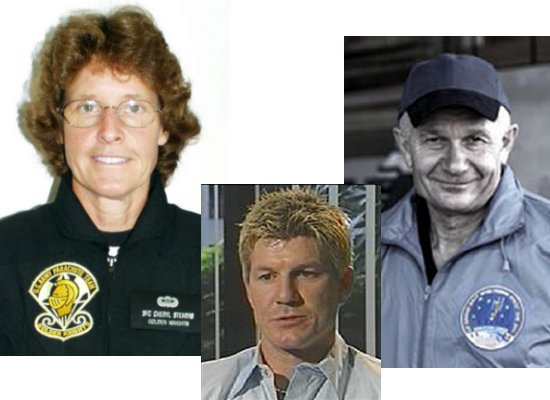
Yet another skydiver planning to make a similar attempt is Frenchman Michel Fournier. His "Le Grand Saut" (The Big Jump) would also occur from 130,000 ft (40,000 m), and Fournier hopes to reach a top speed of about 995 mph (1,600 km/h) or Mach 1.5. Fournier's first attempt came on 5 August 2003 but had to be abandoned after the balloon ripped while being filled with helium. He planned to try again in August 2005, but the attempt had to be cancelled for financial reasons. According to his site,
"Michel Fournier was a victim of a financial swindle by a pseudo sponsor who carried out a false credit transfer on the bank of the Great Jump. Financial means being joined together to ensure a perfect safety of this stratospheric flight, it was decided to carry forward on a later date which we cannot provide at the present time."A final question to consider is why so many sources mistakenly claim that Joseph Kittinger broke the sound barrier during his 1960 skydive. The most likely explanation comes from the fact that these sources typically claim the maximum speed Kittinger reached was 714 mph, just one digit off from the actual speed he attained of 614 mph. If Kittinger had reached the higher speed, he would have indeed been supersonic and achieved approximately Mach 1.05. It seems probable that the author of some official source accidentally miswrote the maximum speed and the mistake has been replicated in numerous locations ever since.
Nevertheless, the actual value of 614 mph comes from Joseph Kittinger himself in a 1960 article he wrote for National Geographic and a subsequent book he authored describing the jump. A direct quote from the former states:
"An hour and thirty-one minutes after launch, my pressure altimeter halts at 103,300 feet. At ground control the radar altimeters also have stopped-on readings of 102,800 feet, the figure that we later agree upon as the more reliable. It is 7 o'clock in the morning, and I have reached float altitude... Though my stabilization chute opens at 96,000 feet, I accelerate for 6,000 feet more before hitting a peak of 614 miles an hour, nine-tenths the speed of sound at my altitude."Kittinger reported that he fell from 102,800 to 96,000 ft before deploying his stabilization parachute. Even with this chute, however, he experienced no noticeable change in acceleration until he fell to 90,000 ft. Using simple physics equations for motion under uniform acceleration, we can estimate Kittinger's velocity. In this case, the acceleration is known since only gravity is acting and we will assume drag is small. We also know the distance traveled by Kittinger under uniform acceleration is about 12,800 ft (3,900 m). The relevant equation in this case is:
where
Solving this equation with the values provided tells us that Kittinger's theoretical top speed is about 905 ft/s
(275 m/s), or 615 mph (990 km/h). This answer is quite close to the top speed reported by Joseph Kittinger in his
publications. We can also rearrange this relationship to solve for the altitude he would have had to jump from in
order to reach 714 mph. In so doing, we find that the Excelsior balloon would have had to have been at an altitude
of about 107,000 ft (32,600 m), or over 4,000 ft (1,300 m) higher than it actually was.
- answer by Joe Yoon, 18 September 2005
Update!
Efforts to break Joe Kittinger's skydive record are still underway. Both American Cheryl Stearns and Frenchman Michel Fournier continue developing their attempts to conduct high-altitude jumps. Stearns has her sights set on a jump from 110,000 ft (33,530 m) although no date has been set.
Fournier has reportedly spent over $20 million in three privately-funded attempts beginning in 2003. Fournier tried again on 27 May 2008 in Saskatchewan, Canada. The effort failed when the balloon detached as it was being filled with helium and floated away. Yet another attempt on 16 May 2010 had to be abandoned when his reserve parachute accidentally deployed inside the capsule during a pre-launch test as the balloon was being inflated. Fournier plans to try again in May 2011 and hopes to jump from 130,000 ft (39,625 m), freefall for 15 minutes, and achieve a speed over 1,000 mph (1,600 km/h).
New contenders have also emerged, including a British stuntman and TV personality named Steve Truglia. Truglia's attempt is called Project Space Jump during which he hopes to break the speed of sound while falling from 120,000 ft (36,575 m). Truglia had planned to make his jump in summer 2010 but this apparently fell through because of funding problems. No further information on his plans has been announced.

Also competing to break the record is an Austrian skydiver and stuntman named
Felix Baumgartner. Baumgartner has already set
several firsts performing numerous B.A.S.E. jumps around the world. He is sponsored by the company Red Bull
planning to set new records for highest altitude in a manned balloon by reaching 120,000 ft (36,575 m), highest
altitude for a skydive, longest freefall distance, and fastest freefall by breaking the speed of sound. The
project is known as Stratos and includes Col. Kittinger
himself as a team member. The project was announced in January 2010 and the skydive attempt was slated to occur
later that year. However, Red Bull stated in October 2010 that Stratos was on hold pending resolution of a lawsuit
with a promoter named Daniel Hogan who claims the company stole the idea from him.
- answer by Jeff Scott, 15 April 2011
Read More Articles:


|
Aircraft | Design | Ask Us | Shop | Search |

|
|
| About Us | Contact Us | Copyright © 1997-2023 | |||
|
|
|||